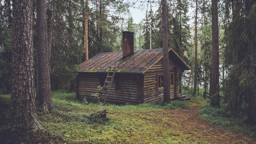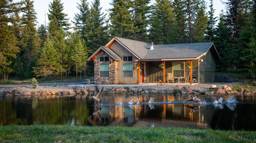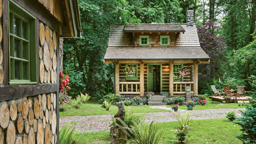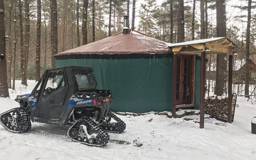MAKING THE LEAP
People often make the transition to full-time cabin life in fits and starts. Perhaps one person retires and the other catches up a year later. Others save up vacation time and spend a few months trying it out before committing. Some folks just put up the For Sale sign and never look back.
Just remember that change can be difficult. Give yourself lots of room to be uncomfortable and unsure. Most of the time, however, life will be downright enjoyable. You can look forward to long weekends with friends and family, afternoons in the sun, leisurely meals at sunset.
Don’t forget to write. We want to hear how you’re doing at the cabin!
Jana Voelke Studelska lives and works in the Upper Midwest. Her only true retirement dream revolves around coral reef winters and summers in her garden.
People often make the transition to full-time cabin life in fits and starts. Perhaps one person retires and the other catches up a year later. Others save up vacation time and spend a few months trying it out before committing. Some folks just put up the For Sale sign and never look back.
Just remember that change can be difficult. Give yourself lots of room to be uncomfortable and unsure. Most of the time, however, life will be downright enjoyable. You can look forward to long weekends with friends and family, afternoons in the sun, leisurely meals at sunset.
Don’t forget to write. We want to hear how you’re doing at the cabin!
Jana Voelke Studelska lives and works in the Upper Midwest. Her only true retirement dream revolves around coral reef winters and summers in her garden.
Maybe the dream started when you were 10 years old, blissful in grandpa’s fishing boat as the morning sun peeked over the treetops, and you felt a tug on the line. Or maybe the dream didn’t hit you until you were busy with your career, when a glass of red wine and a few talkative black-capped chickadees on the deck of a vacation rental made your shoulders relax for the first time in three years. Perhaps you already have a cabin and have been playing the dream out in your mind for years.
No matter how the dream has been at work in your life, maybe it’s time to make the leap – the leap toward realizing that dream of retired life at the cabin.
Here’s a thought: No more wistful looks in the rearview mirror as you drive away after a long weekend.
You wouldn’t be alone. A study by the National Association of Realtors found that four out of 10 second-home owners intend to convert their vacation home into a primary residence in retirement. A full half of the surveyed urban dwellers over the age of 45 said they’d like to retire to a small town or a rural area.
If only making the move from urban hustle to rural route were as easy as packing for a long weekend. Just throw your comfortable clothes and a few towels into a bag and head out.
Turns out there’s a bit more to it than that. Research, planning, timing and some self-examination will make the transition smoother. You have homework to do – but it’s fun homework!
WHAT DO YOU WANT TO BE WHEN YOU GROW UP?
Retirement ain’t what it used to be; not too many people these days are planning only on years of church suppers followed by early bedtimes.
Retirement is about dreams and accomplishments, restructuring leisure, work and productivity. It’s a chance to discover a new set of callings and passions. Some focus on deepening relationships with friends and family, others dedicate themselves to community service or the arts. Still others use the time to bring their professional lives in line with their deeper values.
An AARP study revealed that 70 percent of people 45 and older plan to continue working in their retirement years. Financial stability is certainly a driving force, but the pure enjoyment of work (35 percent of those questioned) or a desire to try something new (17 percent) gives retirement new meaning.
A few generations ago, before social security and full-time leisure became culturally embedded as the “norm,” elders remained productive members of society, relied upon for their insight, wisdom and skills. Indeed, retirement is a relatively new concept in human history.
Retirement at the cabin can mean finding a place that offers the peace and quiet you’re looking forward to, balanced with opportunity and community.
WORKING IT
Many “retirees” bring their work with them to full-time cabin life. They’re able to do some or all their work from a remote setting, with occasional travel to the city for meetings or presentations.
Others start a whole new profession. Cheri and Martin Woodward live in rural Rappahannock County, near the Blue Ridge Mountains of Virginia. They’ve made their home there for 30 years, and in that time owned a mail order business, an art gallery and now – in retirement and living in their dream cabin – work as real estate agents. Most of their clients are people from the Washington, D.C., area who are buying second homes in hopes of retiring there within a few years.
“A lot of people who retire here are doing a partial retirement,” Cheri said. “It’s not like they’re getting up at 8 a.m. and commuting to work. They’re doing something far more interesting. I love my work. It allows me to keep hours that also allow
me time to follow my interests.”
The area in which the Woodwards live attracts retirees for good reason. Just two hours from Washington, D.C., Rappahannock County has only 7,000 residents. But it also has music, arts, dance, fabulous restaurants, wineries and busy B&Bs.
It is also, according to Cheri, much like any other rural area. Making a living – even a partial living – requires flexibility and imagination. The cost of living may be less as a retired person, but wages are generally half of what you might expect in an urban area. It’s a good idea to have at least six months’ savings to fall back on while you’re hunting for work.
If you’re fortunate enough to not have to worry about income, you can focus on following your heart.
Cheri and Martin have chosen to work ratherthan retire full-time. They recently bought a 100-acre farm with an old log cabin and a postcard view of Virginia’s largest mountain, and it costs more than retirement allows.
“But I live here!” Cheri says. “I get to live the dream. It’s a good trade.”
No matter how the dream has been at work in your life, maybe it’s time to make the leap – the leap toward realizing that dream of retired life at the cabin.
Here’s a thought: No more wistful looks in the rearview mirror as you drive away after a long weekend.
You wouldn’t be alone. A study by the National Association of Realtors found that four out of 10 second-home owners intend to convert their vacation home into a primary residence in retirement. A full half of the surveyed urban dwellers over the age of 45 said they’d like to retire to a small town or a rural area.
If only making the move from urban hustle to rural route were as easy as packing for a long weekend. Just throw your comfortable clothes and a few towels into a bag and head out.
Turns out there’s a bit more to it than that. Research, planning, timing and some self-examination will make the transition smoother. You have homework to do – but it’s fun homework!
WHAT DO YOU WANT TO BE WHEN YOU GROW UP?
Retirement ain’t what it used to be; not too many people these days are planning only on years of church suppers followed by early bedtimes.
Retirement is about dreams and accomplishments, restructuring leisure, work and productivity. It’s a chance to discover a new set of callings and passions. Some focus on deepening relationships with friends and family, others dedicate themselves to community service or the arts. Still others use the time to bring their professional lives in line with their deeper values.
An AARP study revealed that 70 percent of people 45 and older plan to continue working in their retirement years. Financial stability is certainly a driving force, but the pure enjoyment of work (35 percent of those questioned) or a desire to try something new (17 percent) gives retirement new meaning.
A few generations ago, before social security and full-time leisure became culturally embedded as the “norm,” elders remained productive members of society, relied upon for their insight, wisdom and skills. Indeed, retirement is a relatively new concept in human history.
Retirement at the cabin can mean finding a place that offers the peace and quiet you’re looking forward to, balanced with opportunity and community.
WORKING IT
Many “retirees” bring their work with them to full-time cabin life. They’re able to do some or all their work from a remote setting, with occasional travel to the city for meetings or presentations.
Others start a whole new profession. Cheri and Martin Woodward live in rural Rappahannock County, near the Blue Ridge Mountains of Virginia. They’ve made their home there for 30 years, and in that time owned a mail order business, an art gallery and now – in retirement and living in their dream cabin – work as real estate agents. Most of their clients are people from the Washington, D.C., area who are buying second homes in hopes of retiring there within a few years.
“A lot of people who retire here are doing a partial retirement,” Cheri said. “It’s not like they’re getting up at 8 a.m. and commuting to work. They’re doing something far more interesting. I love my work. It allows me to keep hours that also allow
me time to follow my interests.”
The area in which the Woodwards live attracts retirees for good reason. Just two hours from Washington, D.C., Rappahannock County has only 7,000 residents. But it also has music, arts, dance, fabulous restaurants, wineries and busy B&Bs.
It is also, according to Cheri, much like any other rural area. Making a living – even a partial living – requires flexibility and imagination. The cost of living may be less as a retired person, but wages are generally half of what you might expect in an urban area. It’s a good idea to have at least six months’ savings to fall back on while you’re hunting for work.
If you’re fortunate enough to not have to worry about income, you can focus on following your heart.
Cheri and Martin have chosen to work ratherthan retire full-time. They recently bought a 100-acre farm with an old log cabin and a postcard view of Virginia’s largest mountain, and it costs more than retirement allows.
“But I live here!” Cheri says. “I get to live the dream. It’s a good trade.”
REALITY CHECK
We all have romantic dreams about moving to the cabin. But the reality is that some of us will experience a dose of culture shock when moving to the cabin full-time. Life will be at a slower pace. As you get more involved in the community, expect a loss of anonymity. You might even find yourself looking at nature in a different way.
The raccoons that were so cute on the weekend are far less charming when they’re full-time, unwanted porch guests. The leafy country lane may turn into the road from hell in winter – even with snow tires and regular plowing.
Mary Phillipp and Dave Johnson, who now live in Orange County, Calif., are wondering what life will be like when they retire. They’re planning to winter in a golf community near Palm Springs and spend summers at their cabin in Minnesota. “What are we going to do up there [at the cabin full-time]?” Dave says. “We’re curious about it. It’s one of our big unknowns. Is it possible to make a transition to a more isolated place?”
After busy careers in Orange County, even nearby Duluth, Minn., with a population of approximately 87,000, will seem like a small town. “The jury’s still out,” Dave laughs. “We don’t really know many people up there except for immediate neighbors on the lake. [Mary and I] look at each other and say, ‘Gosh, can we do this?’”
When the time comes, many people find that full-time cabin living can mean a social life that’s busier than ever. Friends and family often welcome the chance to visit with you at the cabin, and it becomes the place for gatherings.
If you’re planning to retire to the cabin, pack these things in your survival kit: A sense of humor, patience, a large squirt gun to encourage raccoon relocation and a recipe for good brownies. Chocolate always helps grease the wheels of friendship.
We all have romantic dreams about moving to the cabin. But the reality is that some of us will experience a dose of culture shock when moving to the cabin full-time. Life will be at a slower pace. As you get more involved in the community, expect a loss of anonymity. You might even find yourself looking at nature in a different way.
The raccoons that were so cute on the weekend are far less charming when they’re full-time, unwanted porch guests. The leafy country lane may turn into the road from hell in winter – even with snow tires and regular plowing.
Mary Phillipp and Dave Johnson, who now live in Orange County, Calif., are wondering what life will be like when they retire. They’re planning to winter in a golf community near Palm Springs and spend summers at their cabin in Minnesota. “What are we going to do up there [at the cabin full-time]?” Dave says. “We’re curious about it. It’s one of our big unknowns. Is it possible to make a transition to a more isolated place?”
After busy careers in Orange County, even nearby Duluth, Minn., with a population of approximately 87,000, will seem like a small town. “The jury’s still out,” Dave laughs. “We don’t really know many people up there except for immediate neighbors on the lake. [Mary and I] look at each other and say, ‘Gosh, can we do this?’”
When the time comes, many people find that full-time cabin living can mean a social life that’s busier than ever. Friends and family often welcome the chance to visit with you at the cabin, and it becomes the place for gatherings.
If you’re planning to retire to the cabin, pack these things in your survival kit: A sense of humor, patience, a large squirt gun to encourage raccoon relocation and a recipe for good brownies. Chocolate always helps grease the wheels of friendship.
TAKING?A?TEST?DRIVE
Thinking of buying or building a cabin to which you can retire? Do some investigating and experimenting to make sure both the cabin and the region are right for you and year-round living.
? Get a four-season picture of an area by renting a place for a year before making your final decision. You’ll get to know people and the lay of the land.
? Spend some time in your chosen community during the busiest
time of year. Is this a livable place? Is the weekend traffic too much
for you?
? Do the same during the quietest time of year. Does your little town close up five months of the year?
? Consider the weather. Spend time there at the worst time of year. Drive to a local store as if you’ve run out of milk. Take a trip to town and stop in at the library and coffee shop. Do the day-to-day things you wouldn’t think twice about when the weather is pleasant.
? Subscribe to local newspapers. If you’re interested in what’s going on, this is the best way to find out what makes a community tick and how spirited it is.
? Take a walk and start up conversations with people you meet. Are they year-round residents? If so, what do they like best, and least, about living there? Most people are keen to share their knowledge of an area and want to help ease the way for newcomers.
? Consider transportation. How many hours will you have to drive to pick up family from the airport? Is there easy access to the freeway system? What’s the travel time to a big city?
? Decide if your vehicle is right for your area, the terrain and your new driving habits. Rough roads and steep climbs??Think about 4WD or front-wheel drive vehicles. Also keep in mind it may be difficult to obtain parts for foreign-made cars in a timely fashion.
? What’s the healthcare like? Many rural communities rely on volunteer rescue squads and have clinics staffed by one or two doctors. Others are hooked up with larger healthcare systems that offer visiting specialists and remote diagnostic facilities. Be sure you know where the closest hospital is located, and check the place out either online or in person.
? Find out if there are interesting classes or group activities. Might you teach at the local community college? Is there an active arts organization to join?
? If you’re a traveler, you might consider renting out your cabin for part of the year. Find out if there’s a rental service that can manage your property while you’re gone. If none exists, you may have just found yourself a little business!
Thinking of buying or building a cabin to which you can retire? Do some investigating and experimenting to make sure both the cabin and the region are right for you and year-round living.
? Get a four-season picture of an area by renting a place for a year before making your final decision. You’ll get to know people and the lay of the land.
? Spend some time in your chosen community during the busiest
time of year. Is this a livable place? Is the weekend traffic too much
for you?
? Do the same during the quietest time of year. Does your little town close up five months of the year?
? Consider the weather. Spend time there at the worst time of year. Drive to a local store as if you’ve run out of milk. Take a trip to town and stop in at the library and coffee shop. Do the day-to-day things you wouldn’t think twice about when the weather is pleasant.
? Subscribe to local newspapers. If you’re interested in what’s going on, this is the best way to find out what makes a community tick and how spirited it is.
? Take a walk and start up conversations with people you meet. Are they year-round residents? If so, what do they like best, and least, about living there? Most people are keen to share their knowledge of an area and want to help ease the way for newcomers.
? Consider transportation. How many hours will you have to drive to pick up family from the airport? Is there easy access to the freeway system? What’s the travel time to a big city?
? Decide if your vehicle is right for your area, the terrain and your new driving habits. Rough roads and steep climbs??Think about 4WD or front-wheel drive vehicles. Also keep in mind it may be difficult to obtain parts for foreign-made cars in a timely fashion.
? What’s the healthcare like? Many rural communities rely on volunteer rescue squads and have clinics staffed by one or two doctors. Others are hooked up with larger healthcare systems that offer visiting specialists and remote diagnostic facilities. Be sure you know where the closest hospital is located, and check the place out either online or in person.
? Find out if there are interesting classes or group activities. Might you teach at the local community college? Is there an active arts organization to join?
? If you’re a traveler, you might consider renting out your cabin for part of the year. Find out if there’s a rental service that can manage your property while you’re gone. If none exists, you may have just found yourself a little business!
Designing & Furnishing an All-Age-Friendly Retreat
by Gina Chiodi Grensing
For retiring cabin owners (and cabin owners who have older guests) it may be time to think about the functionality of your getaway with regard to that sly mobility-stealer: age.
Making practical interior design and furnishing decisions can go a long way towards achieving a friendlier, safer and more enjoyable living environment for those in retirement.
Try the ideas below, as suggested by Furniture.com lead designer Davis Remignanti, to create an all-age-friendly retreat.
? Private sanctuary: Have a bedroom on the main level. Choose a bed that offers easy access (onto and off) along with appropriate support and comfort.
? Light it up: Ease eyestrain with additional task lighting in areas used for detailed work, like reading and hobbies. Put nightlights in hallways for those nocturnal trips to the bathroom.
? Workable kitchen: Create a seated work area for food preparation tasks. Dedicate a small table and chair in a comfortable location as a workplace with nearby access to utensils.
? Easy storage: Provide easily accessible storage that doesn’t require reaching, bending or straining. Have a sturdy step stool handy. Choose dressers and wardrobes with large or D-loop handles for easy opening. Many dressers feature easy-rolling guides and built-in safety stops.
? Supportive furniture: Look for chairs, sofas and dining chairs that have good back support and strong, sturdy arms.
? Hold it: Install a second stairway railing on the opposite wall for a double dose of steadiness.Consider adding grab bars on the walls alongside the toilet and in the shower and bathtub.
? Open up: Replace doorknobs with lever-style handles, so doors are easy to open.
? Clear the path: If building or remodeling, consider installing extra wide doorways, walkways and
stairs.
RESOURCES:
• Furniture.com - www.furniture.com
• National Aging In Place Council - www.naipc.org
• AARP - www.aarp.org/families/home_design/
• This Old House - www.thisoldhouse.com/toh/article/0,,519817,00.html
by Gina Chiodi Grensing
For retiring cabin owners (and cabin owners who have older guests) it may be time to think about the functionality of your getaway with regard to that sly mobility-stealer: age.
Making practical interior design and furnishing decisions can go a long way towards achieving a friendlier, safer and more enjoyable living environment for those in retirement.
Try the ideas below, as suggested by Furniture.com lead designer Davis Remignanti, to create an all-age-friendly retreat.
? Private sanctuary: Have a bedroom on the main level. Choose a bed that offers easy access (onto and off) along with appropriate support and comfort.
? Light it up: Ease eyestrain with additional task lighting in areas used for detailed work, like reading and hobbies. Put nightlights in hallways for those nocturnal trips to the bathroom.
? Workable kitchen: Create a seated work area for food preparation tasks. Dedicate a small table and chair in a comfortable location as a workplace with nearby access to utensils.
? Easy storage: Provide easily accessible storage that doesn’t require reaching, bending or straining. Have a sturdy step stool handy. Choose dressers and wardrobes with large or D-loop handles for easy opening. Many dressers feature easy-rolling guides and built-in safety stops.
? Supportive furniture: Look for chairs, sofas and dining chairs that have good back support and strong, sturdy arms.
? Hold it: Install a second stairway railing on the opposite wall for a double dose of steadiness.Consider adding grab bars on the walls alongside the toilet and in the shower and bathtub.
? Open up: Replace doorknobs with lever-style handles, so doors are easy to open.
? Clear the path: If building or remodeling, consider installing extra wide doorways, walkways and
stairs.
RESOURCES:
• Furniture.com - www.furniture.com
• National Aging In Place Council - www.naipc.org
• AARP - www.aarp.org/families/home_design/
• This Old House - www.thisoldhouse.com/toh/article/0,,519817,00.html
 Kathy Wynn, dreamstime.com
Kathy Wynn, dreamstime.com  Daniela Spyropoulou, dreamstime.com
Daniela Spyropoulou, dreamstime.com 










